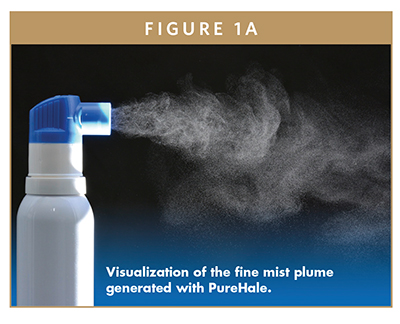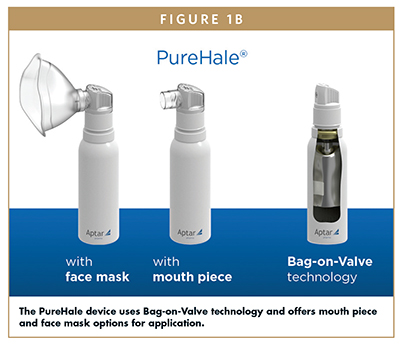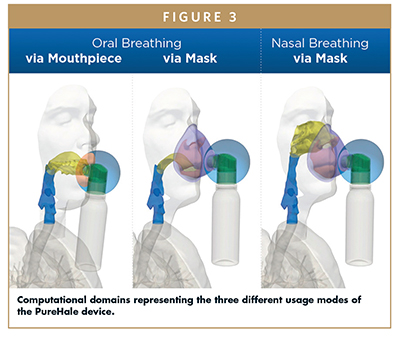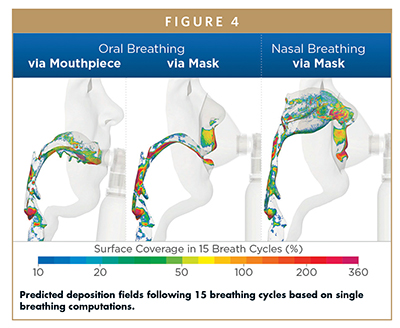Issue:September 2021
DELIVERY DEVICE - Aerosol Deposition Characterization of Innovative PureHale® Technology Targeting the Upper Airways
INTRODUCTION
The nose and upper respiratory system function as a path for air to enter the body while contributing to olfactory function, conditioning the breathed-in air and removing debris. Serving as a primary contact point with the environment, they can be a route for the entry of contaminants or disease as well as a site for healing and protection using the latest targeted delivery technologies.
Moisturizing the upper airways can provide symptom relief for a variety of upper airway conditions and can also reduce the risk of viral infections because of improved mucociliary clearance (MCC). Recent studies have demonstrated the potential effectiveness of targeted administration of anti-viral or protective formulations to nasal mucosa for preventing viral infections.1 With the ability to treat the upper airways by only using specialized inhalation delivery methods, one can deliver a targeted aerosol that simultaneously minimizes deposition levels in the lower airways.
Aptar Pharma’s novel PureHale® ready-to-use nebulizer-like device was specifically developed to target the upper respiratory tract while minimizing deposition in the lower airways. PureHale provides a modern device option for the delivery of a fine mist for a variety of solutions to only the upper respiratory tract without significant deposition in the lungs and lower airways.
The PureHale system is based on Aptar Pharma’s well-established Bag-on-Valve Technology Platform and uses an innovative actuator technology capable of producing a fine mist. The device generates a continuous fine mist with a mean droplet size of approximately 15 μm to 20 μm at a continuous output rate of ~1 ml per minute, visualized in Figure 1A. PureHale’s Bag-on-Valve system requires no external power source or batteries. Inside an aluminum can, a multilayered bag serves as the reservoir for the product formulation, protected inside the bag from any environmental or propellant interaction. By turning the actuator, the unidirectional valve opens and, by means of pressurized air or any other environmentally uncritical propellant in the can, the product solution is forced at a distinct pressure through the innovative nozzle system thereby producing the desired droplet sizes and distribution.

When developing the PureHale system, Aptar Pharma performed extensive testing to demonstrate and evaluate the effectiveness of the system’s ability to deliver the required fine mist to the targeted upper respiratory tract with the desired deposition pattern. Data was generated for both face mask and mouthpiece applications, using different breathing patterns, with the expectation that the combinations would show significantly different deposition of the tested formulations to specific areas of the upper respiratory tract.
Two complementary methods were combined for these studies to simulate the entire upper and lower respiratory tracts:
- Next Generation Impactor (NGI) – differentiates deposition between upper and lower respiratory tracts.
- Computational Fluid Particle Dynamics (CFPD) – provides detailed deposition patterns and quantitative deposition fractions.
By combining NGI and CFPD technologies, a complete test method simulating the entire respiratory tract and its anatomy was created that provided data defining differential deposition patterns that PureHale achieves in the upper airways. Additionally, the designed tests could shed light on the specific deposition patterns within the entire region of interest, from the nasopharyngeal area through to the throat and larynx.
Based on the findings of the in-vitro and in-silico studies, we concluded that PureHale could effectively support targeted treatments for the prevention, protection, or cure of conditions affecting the upper respiratory tract, by moistening, cleansing, and soothing the upper airways. This could include solutions for applications such as infections or viral protection of the upper respiratory tract.
CASCADE IMPACTOR STUDIES
Several data measurement techniques were used for the Cascade Impactor Studies. Most simply, the total flow rate of the PureHale samples were determined by weighing them before and after continuous operation for 60 seconds. Initial droplet size characterization was conducted using a laser diffraction Malvern Spraytec. The Cascade Impactor model required a more complex setup to mimic the entire upper respiratory tract. For the study, a commonly available Next Generation Pharmaceutical Impactor was used, specifically designed for pharmaceutical inhaler testing with a focus on lower airway deposition. This was used in combination with an Alberta Idealized Throat (AIT) to simulate the upper airways. The Alberta Idealized Throat was specifically designed to mimic the aerosol deposition and flow in the human mouth-throat region. This two-component setup allowed the simulated measurement of the deposition of the PureHale mist when breathing through the mouth.
The experiment was conducted using the standard mouthpiece (Figure 1B), either being placed directly to the orifice of the AIT or at a distance of approximately 4 cm, simulating a spacer. Through this spacing approach, inhalation and exhalation were intended to be separated in order to achieve a higher deposition in the airways.
To complete the test system for simulation of nose breathing and the use of a face mask (Figure 1B), a special upper airway model was created. The geometry is based on a characteristic pediatric geometry of the mouth-throat and nose-throat region (developed in the Pharmaceutical Physics Laboratory of Boehringer Ingelheim Pharma GmbH & Co. KG assessed via https://www.rddonline.com). This geometry was scaled-up by a factor of 1.5 in three dimensions to better fit the size of the test equipment and the face masks, and to bring it closer to an adult geometry. The face-nose model was printed with FotoMed® LED.A at 3D-LABS GmbH.

A flow rate of 15 L/min was applied for the experiments, simulating sinusoidal breathing at 15 breaths/min (as described in USP 39 <1601> Products for Nebulization / General Information). Each experiment lasted 60 continuous seconds with at least three repetitions per simulation. For the NGI studies, the PureHale test samples were filled with fluorescein-sodium dye dissolved in deionized water (40 mg/ml fluorescein) and pressurized. The deposited formulation was retrieved for quantitation by carefully washing the different sections of the described model. Samples were photometrically analyzed at a wavelength of 487 nm to determine fluorescein concentration. Then, with the determined fluorescein concentration deposition quantities were calculated based on the washing volumes collected from each section (Figure 2).

Deposition in the upper airway reached a high of 34% when the mouthpiece of the actuator was placed in the orifice of the AIT during oral breathing. When the mouthpiece was positioned at an additional distance of 4 cm from the orifice during breathing, the deposition measured was slightly higher at 38%. Finally, when using the facemask with PureHale during nasal breathing (not by mouth), the upper airway deposition was significantly lower at approximately 9% as expected. In all three scenarios, the data demonstrated a range of upper respiratory deposition of 9.2% to 37.9% in contrast to minor lower airway deposition ranging from 0.96% to 2.2%. This clearly demonstrates that the PureHale system provides comprehensive deposition in the upper airway but very limited deposition in the lower airway.
COMPUTATIONAL FLUID PARTICLE DYNAMICS (CFPD) SIMULATION
Some technical limitations of the modified impactor model became apparent through the studies conducted including the fact that the scaled-up face/nose model does not accurately represent an adult anatomy. We decided to apply appropriate Computational Fluid Particle Dynamics (CFPD) modeling to overcome some of these challenges and gather more definitive data. CFPD is an in-silico approach that solves conservation laws at high spatial and temporal resolution to emulate the fundamental behavior of fluids and particles in these systems. The first step in developing the CFPD model is the construction of the computational domain, which consists of the upper airways and the PureHale device with mouthpiece or face mask. The digital geometry of the inhaler was already available from the Computer-Aided Design (CAD) drawings, but the digital geometry of the upper airways had to be constructed. To generate a model, 3D face scanning technology was used in order to define the facial characteristics of a subject while inhaling with the PureHale device. The upper airway properties were generated from medical CT/MRI images of different subjects but all with strong anatomical correlation. Nasal cavities were derived from head CT scan images, while the oral cavity and throat region were established from neck MRI images. Lastly, a partial tracheobronchial airway tree was generated from chest CT image sources. All of these data points contributed to accurately defining the upper airways in the CFPD model used in the simulations.
The second step in CFPD modeling is the generation of the grid, a process in which the computational domain is subdivided into smaller connected elements. The grid elements act as data generating points, measuring the airflow during breathing emulation. Higher grid densities lead to superior airflow resolution but with a significantly greater computational cost. Typically, a balance between resolution and cost is sought, with increased grid densities applied only to regions of important airflow and particle transport phenomena. For the purposes of this study, we have used various grids with tens of millions of elements. The largest grid size used was approximately 52 million elements, and it was simulated on 280 CPU cores with 2.4 GHz processor speed for approximately 70 days.
CFPD technology was used to simulate the aerosol release from the PureHale system and subsequent deposition in the extra thoracic airways. Data for a full breathing cycle with period duration of T = 2 seconds were calculated. Prior to the analyzed breathing cycle, an initialization process was simulated to subsequently emulate the aerosol deposition under a steady state breathing cycle. A sinusoidal breathing profile was applied with an average flowrate of Q = 15 L/minute corresponding to normal breathing at rest. Airflow turbulence was modeled via the Large Eddy Simulation (LES) methodology. For the fine mist with a large aerosol-to-air density ratio, only the critical forces acting on the aerosols were taken into account (ie, Drag and Gravity, and to a lesser extent the Buoyancy and Shear Lift). Accounting for the effect of aerosols on the airflow, an appropriate two-way coupling source term was applied to the airflow equations.
The simulations assumed an isotonic saline solution (0.9% w/v NaCl in water) was being injected from the 48 holes of the PureHale nozzle toward the patient. In real life, the injection process initially forms jet streams, but as they interact with the surrounding air, they become unstable and break into droplets. These interaction forces between droplets are not accounted for in the simulations. As a result, droplets were injected from the beginning of the simulation at the final expected droplet size using a consistent mass and momentum approach. In the simulations, the diameter of the droplets was set at d = 15 μm. Three different inhaler usage modes were studied (Figure 3).

One of the many simulation outputs was the deposition sites of injected droplets. The deposition locations and densities can be visualized simultaneously via the surface coverage fields. Figure 4 shows the estimated airway surface coverage fields after 15 breathing cycles for the three inhaler usage modes. These fields are estimated from single breathing computations extrapolated to represent 15 breathing cycles with the upper limit of the logarithmic scale bar reflecting the single cycle coverage. Local values above 100% indicate that the site surface would be fully covered with droplets plus a potential excess of droplets. Under this condition, the local liquid film formed could spill to the neighboring locations, but we have not accounted for this scenario as we wanted to highlight the most conservative case.

The simulation data clearly shows that airway coverage is substantial under all three breathing modes. Standard nasal sprays provide much more localized and concentrated nasal coverage, but the PureHale system provides more substantial coverage of the entire upper respiratory system being simulated. Furthermore, additional simulations indicate that an oral inhalation followed by a nasal exhalation provides complementary coverage of the nasopharynx-associated lymphoid tissue (NALT) region as compared to the simple nasal breathing maneuver. The NALT region, located at the rear end of the nasal breathing channel, is of particular interest because it is known to play a significant role in the development of mucosal immunity cells. Being able to deliver fine mists to this region can contribute to improved mucociliary clearance, immunology, or general nasal disinfection.
We looked at Deposition Fractions (DF) for a more quantitative measurement of these processes. Figure 5 compares the in-vitro and in-silico DFs where we separate the upper and lower airway deposition data. In general, the correlation of results between the actual experiments (where conducted) and the simulations are very strong and these variations can be attributed to the different models used between experiments and simulations. The data demonstrates that upper airway deposition is significantly higher than lower airway deposition and that unwanted tracheobronchial (TB) deposition is limited under all three breathing modes using the PureHale system.

ABOUT THE PUREHALE SYSTEM
PureHale is a novel fine mist-generating device with a high output rate of ~1 ml/min and delivers droplet sizes between 15 μm and 20 μm optimal for deposition in the upper airways. For effective use, operation of the device for at least 60 to 90 seconds per session is recommended. Addressing an unmet market need, PureHale’s cordless, user-friendly system was engineered for on-the-go use anytime, anywhere. Unlike traditional nebulizers, the PureHale device requires no electrical energy source and is conveniently powered by pre-filled compressed inert gas or air in the product can for simple use wherever and whenever needed. PureHale also provides the flexibility of delivery via a mouthpiece or face mask, offering adaptable treatment options for everyone, from children to the elderly.
CONCLUSIONS
Aptar Pharma has performed a series of experiments that successfully demonstrate the ability of the PureHale technology system to reliably deliver small droplet mists to the upper respiratory tract on a targeted basis, with little deposition in the lower respiratory airways including the lungs. The Cascade Impactor studies as well as the CFPD simulations demonstrated a relatively high deposition rate in all three face mask or mouthpiece configurations with depositions in the upper respiratory tract ranging from 9.2% to 37.9% across the targeted areas, in contrast with negligible lower airway deposition ranging from 0.96% to 2.2%. Nasal airway deposition, specifically targeting the NALT region, can also be enhanced by breathing in through the mouth and subsequently exhaling via the nose, with the mouth acting as a kind of spacer.
Although the experiments and simulations utilized a simple 0.9% saline solution as a test case, the PureHale technology system may be ideal for a range of other applications that require targeted coverage of the upper respiratory tract with a fine mist, and negligible deposition in the lower airways. The self-contained, portable system is easy-to-use for both young and old and essentially unifies the delivery benefits of traditional nasal sprays with gargles for the upper airways.
A simple saline solution can be very well suited for the moistening of the upper airways in order to restore mucociliary clearance mechanisms caused by upper respiratory tract infections, allergies, colds, or other sources of nasal irritation. Viruses causing airway infections can adhere to and replicate in the upper airways, which can be specifically targeted by the PureHale technology platform and its comprehensive deposition pattern. Therefore, antiviral or antiseptic formulations applied via PureHale technology may be able to prevent or minimize the impact of an upper airway infection. Aerosols delivered by the Purehale technology system could be used to deliver a range of symptom relief or prophylactic benefits for users. Other applications for the PureHale technology platform could include aroma or halo therapies.
In summary, Aptar Pharma’s PureHale technology platform combines convenient, portable ease of use with comprehensive mist deposition patterns across the targeted upper airway systems for a wide range of potential applications and solution types.
REFERENCE
- Victoria Corless, Advanced Science News, 18 June 2021: A nasal spray to prevent virus infections. https://www.advancedsciencenews.com/a-nasal-spray-to-prevent-viral-infection/.

Dr. Degenhard Marx is Director of Scientific Affairs Aptar Pharma’s Consumer Health Care Division. Following his study of Veterinary Medicine, and the successful completion of his thesis at the University of Leipzig in 1992, he joined the pharmaceutical industry. During his career, he has gained extensive experience in the drug development for anti-inflammatory, respiratory and cardiovascular drugs.

Dr. Fotos Stylianou is a Postdoctoral Researcher in the Department of Mechanical and Manufacturing Engineering at the University of Cyprus, from which he earned his PhD degree in 2016. He also earned BSc and MSc degrees in Physics. In 2010, he joined the Computational Sciences Laboratory (UCY-CompSci) and has been involved in research projects funded by various pharmaceutical companies.

Dr. Stavros Kassinos is a Professor in the Department of Mechanical and Manufacturing Engineering at the University of Cyprus and the Head of the Computational Sciences Laboratory (UCY-CompSci). His works on the numerical simulation and modeling of complex physical systems include turbulent fluid-particle flows for environmental, biomedical, and technological applications. In particular, he is interested in the further development of in-silico methods in support of inhaled drug development.
Total Page Views: 6075










